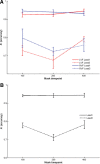Topographic contribution of early visual cortex to short-term memory consolidation: a transcranial magnetic stimulation study
- PMID: 22219265
- PMCID: PMC6621312
- DOI: 10.1523/JNEUROSCI.3261-11.2012
Topographic contribution of early visual cortex to short-term memory consolidation: a transcranial magnetic stimulation study
Abstract
The neural correlates for retention of visual information in visual short-term memory are considered separate from those of sensory encoding. However, recent findings suggest that sensory areas may play a role also in short-term memory. We investigated the functional relevance, spatial specificity, and temporal characteristics of human early visual cortex in the consolidation of capacity-limited topographic visual memory using transcranial magnetic stimulation (TMS). Topographically specific TMS pulses were delivered over lateralized occipital cortex at 100, 200, or 400 ms into the retention phase of a modified change detection task with low or high memory loads. For the high but not the low memory load, we found decreased memory performance for memory trials in the visual field contralateral, but not ipsilateral to the side of TMS, when pulses were delivered at 200 ms into the retention interval. A behavioral version of the TMS experiment, in which a distractor stimulus (memory mask) replaced the TMS pulses, further corroborated these findings. Our findings suggest that retinotopic visual cortex contributes to the short-term consolidation of topographic visual memory during early stages of the retention of visual information. Further, TMS-induced interference decreased the strength (amplitude) of the memory representation, which most strongly affected the high memory load trials.
Figures



Similar articles
-
Posttraining transcranial magnetic stimulation of striate cortex disrupts consolidation early in visual skill learning.J Neurosci. 2012 Feb 8;32(6):1981-8. doi: 10.1523/JNEUROSCI.3712-11.2011. J Neurosci. 2012. PMID: 22323712 Free PMC article. Clinical Trial.
-
The impact of early visual cortex transcranial magnetic stimulation on visual working memory precision and guess rate.PLoS One. 2017 Apr 6;12(4):e0175230. doi: 10.1371/journal.pone.0175230. eCollection 2017. PLoS One. 2017. PMID: 28384347 Free PMC article.
-
Causal evidence for subliminal percept-to-memory interference in early visual cortex.Neuroimage. 2012 Jan 2;59(1):840-5. doi: 10.1016/j.neuroimage.2011.07.062. Epub 2011 Aug 2. Neuroimage. 2012. PMID: 21839180
-
Transcranial magnetic stimulation of visual cortex in memory: cortical state, interference and reactivation of visual content in memory.Behav Brain Res. 2013 Jan 1;236(1):67-77. doi: 10.1016/j.bbr.2012.08.001. Epub 2012 Aug 19. Behav Brain Res. 2013. PMID: 22921373 Review.
-
Transcranial magnetic stimulation as an investigative tool in the study of visual function.Optom Vis Sci. 2003 May;80(5):356-68. doi: 10.1097/00006324-200305000-00010. Optom Vis Sci. 2003. PMID: 12771661 Review.
Cited by
-
A classification-based generative approach to selective targeting of global slow oscillations during sleep.Front Hum Neurosci. 2024 Feb 13;18:1342975. doi: 10.3389/fnhum.2024.1342975. eCollection 2024. Front Hum Neurosci. 2024. PMID: 38415278 Free PMC article.
-
The causal involvement of the visual cortex in visual working memory remains uncertain.R Soc Open Sci. 2024 Jun 12;11(6):231884. doi: 10.1098/rsos.231884. eCollection 2024 Jun. R Soc Open Sci. 2024. PMID: 39092143 Free PMC article.
-
Partial dissociation in the neural bases of VSTM and imagery in the early visual cortex.Neuropsychologia. 2015 Aug;75:143-8. doi: 10.1016/j.neuropsychologia.2015.05.026. Epub 2015 May 27. Neuropsychologia. 2015. PMID: 26026256 Free PMC article.
-
Spatial Attention in Visual Working Memory Strengthens Feature-Location Binding.Vision (Basel). 2023 Dec 18;7(4):79. doi: 10.3390/vision7040079. Vision (Basel). 2023. PMID: 38133482 Free PMC article.
-
State-dependent effects of neural stimulation on brain function and cognition.Nat Rev Neurosci. 2022 Aug;23(8):459-475. doi: 10.1038/s41583-022-00598-1. Epub 2022 May 16. Nat Rev Neurosci. 2022. PMID: 35577959 Review.
References
-
- Alvarez GA, Cavanagh P. The capacity of visual short-term memory is set both by visual information load and by number of objects. Psychol Sci. 2004;15:106–111. - PubMed
-
- Amassian VE, Cracco RQ, Maccabee PJ, Cracco JB, Rudell A, Eberle L. Suppression of visual perception by magnetic coil stimulation of human occipital cortex. Electroencephalogr Clin Neurophysiol. 1989;74:458–462. - PubMed
-
- Beckers G, Hömberg V. Impairment of visual perception and visual short term memory scanning by transcranial magnetic stimulation of occipital cortex. Exp Brain Res. 1991;87:421–432. - PubMed
-
- Boroojerdi B, Bushara KO, Corwell B, Immisch I, Battaglia F, Muellbacher W, Cohen LG. Enhanced excitability of the human visual cortex induced by short-term light deprivation. Cereb Cortex. 2000;10:529–534. - PubMed
-
- Breitmeyer BG, Ogmen H. Recent models and findings in visual backward masking: a comparison, review, and update. Percept Psychophys. 2000;62:1572–1595. - PubMed
Publication types
MeSH terms
LinkOut - more resources
Full Text Sources
